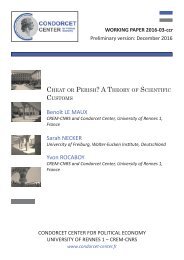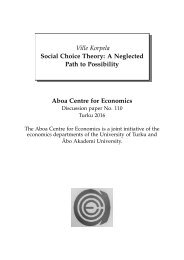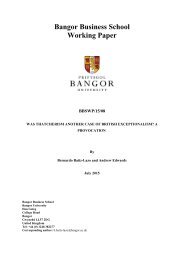MEMORANDUM
n?u=RePEc:hhs:osloec:2016_018&r=hpe
n?u=RePEc:hhs:osloec:2016_018&r=hpe
Create successful ePaper yourself
Turn your PDF publications into a flip-book with our unique Google optimized e-Paper software.
Leontief enjoyed New York. At Leontief’s request before he left Kiel, Schumpeter<br />
had sent him suggestions for people to meet in New York. In addition to Mitchell and<br />
Kuznets at NBER, Schumpeter had suggested John Maurice Clark and Ralph Souter at<br />
Columbia. 172 He enclosed with the letter to Leontief a greeting card for Henry Moore<br />
whom Schumpeter described as suffering and withdrawn. Moore had retired in 1929 and<br />
Leontief didn’t get to see him.<br />
At Columbia Leontief instead met Harold Hotelling who was an outlier at Columbia at<br />
that time as the only non-institutionalist. Hotelling had indeed been hired to take over<br />
Henry Moore’s courses in mathematical statistics and mathematical economics. 173<br />
Schumpeter had furthermore mentioned Carl Snyder at the Federal Reserve Bank of New<br />
York and also the blind Mr. Thomas, whom Schumpeter held to be one of the most gifted<br />
economists of the day. Leontief visited the Fed and met Thomas and several other young<br />
economists.<br />
In the beginning of December 1931 Leontief explained to Schumpeter what his<br />
ongoing work was:<br />
“The basic idea of my current work is the following. The ‘empirical’ explanation of<br />
economic changes must start with the isolation of primary changes from secondary<br />
ones, which can be regarded as the response of the total system. It can theoretically<br />
(mathematically) be shown that when an essential change, a ‘new combination’ i.e.<br />
an elasticity shift, occurs in any point of the economic circulation, then this will call<br />
forth in all other and particularly in the ‘neighboring’ parts of the system quite<br />
specific shifts (both in size and direction) of the supply and demand curves.<br />
If the elasticities of the individual markets are known, then the level shifts<br />
can be measured. And if the latter are determined for the ‘strategically’ important<br />
points of the circular flow, then deductions can be drawn from their configuration<br />
about probable location of the primary change at stake. The results I have achieved<br />
so far show that the task is not hopeless.” (Leontief to Schumpeter, 15 Dec. 1931,<br />
transl. by ob).<br />
This is an informative passage in view of Leontief’s earlier work and our knowledge<br />
of where he was heading, although disappointingly brief. The keyword in the description<br />
was “economic changes.” Leontief was clearly struggling with a theoretical framework of<br />
general equilibrium character, comprising several industrial markets, not necessarily<br />
172 J.M. Clark was a leading institutionalist but carried with him also parts of the neoclassical legacy<br />
of his father, J.B. Clark. Both had been invited charter members of the Econometric Society. R.<br />
Souter was from New Zealand and at Columbia 1930-35.<br />
173 Rutherford (2004, p.50).<br />
73





